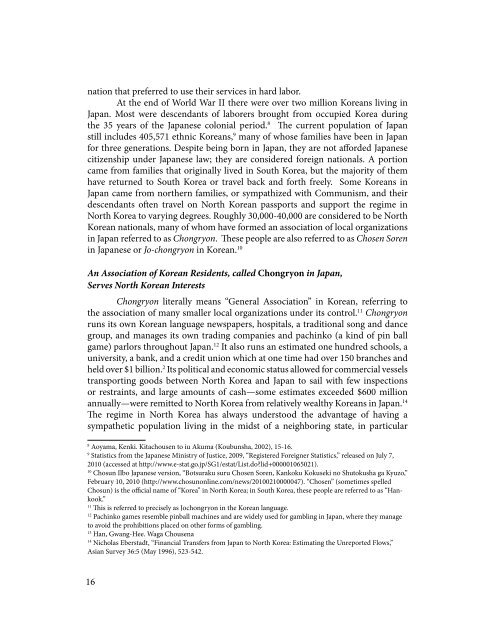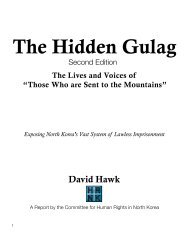Taken! - US Committee for Human Rights in North Korea
Taken! - US Committee for Human Rights in North Korea
Taken! - US Committee for Human Rights in North Korea
- No tags were found...
Create successful ePaper yourself
Turn your PDF publications into a flip-book with our unique Google optimized e-Paper software.
nation that preferred to use their services <strong>in</strong> hard labor.At the end of World War II there were over two million <strong>Korea</strong>ns liv<strong>in</strong>g <strong>in</strong>Japan. Most were descendants of laborers brought from occupied <strong>Korea</strong> dur<strong>in</strong>gthe 35 years of the Japanese colonial period. 8 The current population of Japanstill <strong>in</strong>cludes 405,571 ethnic <strong>Korea</strong>ns, 9 many of whose families have been <strong>in</strong> Japan<strong>for</strong> three generations. Despite be<strong>in</strong>g born <strong>in</strong> Japan, they are not af<strong>for</strong>ded Japanesecitizenship under Japanese law; they are considered <strong>for</strong>eign nationals. A portioncame from families that orig<strong>in</strong>ally lived <strong>in</strong> South <strong>Korea</strong>, but the majority of themhave returned to South <strong>Korea</strong> or travel back and <strong>for</strong>th freely. Some <strong>Korea</strong>ns <strong>in</strong>Japan came from northern families, or sympathized with Communism, and theirdescendants often travel on <strong>North</strong> <strong>Korea</strong>n passports and support the regime <strong>in</strong><strong>North</strong> <strong>Korea</strong> to vary<strong>in</strong>g degrees. Roughly 30,000-40,000 are considered to be <strong>North</strong><strong>Korea</strong>n nationals, many of whom have <strong>for</strong>med an association of local organizations<strong>in</strong> Japan referred to as Chongryon. These people are also referred to as Chosen Soren<strong>in</strong> Japanese or Jo-chongryon <strong>in</strong> <strong>Korea</strong>n. 10An Association of <strong>Korea</strong>n Residents, called Chongryon <strong>in</strong> Japan,Serves <strong>North</strong> <strong>Korea</strong>n InterestsChongryon literally means “General Association” <strong>in</strong> <strong>Korea</strong>n, referr<strong>in</strong>g tothe association of many smaller local organizations under its control. 11 Chongryonruns its own <strong>Korea</strong>n language newspapers, hospitals, a traditional song and dancegroup, and manages its own trad<strong>in</strong>g companies and pach<strong>in</strong>ko (a k<strong>in</strong>d of p<strong>in</strong> ballgame) parlors throughout Japan. 12 It also runs an estimated one hundred schools, auniversity, a bank, and a credit union which at one time had over 150 branches andheld over $1 billion. 2 Its political and economic status allowed <strong>for</strong> commercial vesselstransport<strong>in</strong>g goods between <strong>North</strong> <strong>Korea</strong> and Japan to sail with few <strong>in</strong>spectionsor restra<strong>in</strong>ts, and large amounts of cash—some estimates exceeded $600 millionannually—were remitted to <strong>North</strong> <strong>Korea</strong> from relatively wealthy <strong>Korea</strong>ns <strong>in</strong> Japan. 14The regime <strong>in</strong> <strong>North</strong> <strong>Korea</strong> has always understood the advantage of hav<strong>in</strong>g asympathetic population liv<strong>in</strong>g <strong>in</strong> the midst of a neighbor<strong>in</strong>g state, <strong>in</strong> particular8Aoyama, Kenki. Kitachousen to iu Akuma (Koubunsha, 2002), 15-16.9Statistics from the Japanese M<strong>in</strong>istry of Justice, 2009, “Registered Foreigner Statistics,” released on July 7,2010 (accessed at http://www.e-stat.go.jp/SG1/estat/List.do?lid+000001065021).10Chosun Ilbo Japanese version, “Botsuraku suru Chosen Soren, Kankoku Kokuseki no Shutokusha ga Kyuzo,”February 10, 2010 (http://www.chosunonl<strong>in</strong>e.com/news/20100210000047). “Chosen” (sometimes spelledChosun) is the official name of “<strong>Korea</strong>” <strong>in</strong> <strong>North</strong> <strong>Korea</strong>; <strong>in</strong> South <strong>Korea</strong>, these people are referred to as “Hankook.”11This is referred to precisely as Jochongryon <strong>in</strong> the <strong>Korea</strong>n language.12Pach<strong>in</strong>ko games resemble p<strong>in</strong>ball mach<strong>in</strong>es and are widely used <strong>for</strong> gambl<strong>in</strong>g <strong>in</strong> Japan, where they manageto avoid the prohibitions placed on other <strong>for</strong>ms of gambl<strong>in</strong>g.13Han, Gwang-Hee. Waga Chousena14Nicholas Eberstadt, “F<strong>in</strong>ancial Transfers from Japan to <strong>North</strong> <strong>Korea</strong>: Estimat<strong>in</strong>g the Unreported Flows,”Asian Survey 36:5 (May 1996), 523-542.an American ally. Several senior Chongryon officials are af<strong>for</strong>ded memberships <strong>in</strong><strong>North</strong> <strong>Korea</strong>’s rubber-stamp legislature, the Supreme People’s Assembly. The CentralHeadquarters of Chongryon is <strong>in</strong> Tokyo and serves as a de facto embassy <strong>for</strong> <strong>North</strong><strong>Korea</strong>, s<strong>in</strong>ce Japan and <strong>North</strong> <strong>Korea</strong> have no official diplomatic ties.Chongryon’s school system has played an important role <strong>in</strong> promot<strong>in</strong>gthe <strong>North</strong> <strong>Korea</strong>n regime’s <strong>in</strong>fluence <strong>in</strong> Japan. It teaches Kim Il Sung’s writ<strong>in</strong>gs,and classes generally start with vows of loyalty to the <strong>North</strong> <strong>Korea</strong>n leader. Theseschools have also helped recruit people whom the regime thought could be helpful,facilitated the <strong>North</strong>’s espionage ef<strong>for</strong>ts <strong>in</strong> Japan, and sponsored programs that tookpeople to <strong>North</strong> <strong>Korea</strong> who were never allowed to return to their homes <strong>in</strong> Japan.Some <strong>Korea</strong>n Residents <strong>in</strong> Japan Migrated to<strong>North</strong> <strong>Korea</strong> Expect<strong>in</strong>g A Better LifeStart<strong>in</strong>g <strong>in</strong> the years after the <strong>Korea</strong>n War, many ethnic <strong>Korea</strong>ns wereencouraged to leave Japan and return to <strong>Korea</strong>. 15 The majority were from South<strong>Korea</strong>n families and almost one and one half million went to South <strong>Korea</strong>. Undera Chongryon-<strong>in</strong>itiated project known as the Resident-<strong>Korea</strong>n Returnees Project,those whose families had come from <strong>North</strong> <strong>Korea</strong>, or had sympathy <strong>for</strong> the regime,were urged to return to their motherland with the hope of build<strong>in</strong>g a prosperoussocialist state. These return<strong>in</strong>g immigrants were <strong>in</strong>tended to supplement the <strong>North</strong><strong>Korea</strong>n labor <strong>for</strong>ce after it was decimated dur<strong>in</strong>g the <strong>Korea</strong>n War. 16 Dur<strong>in</strong>g thisperiod, Kim Il-sung’s <strong>North</strong> <strong>Korea</strong> was promoted as a “paradise.” As Kang Cholhwan,a grandson of one of the returnees wrote, “The leaders of the Chosen Sorenwere very keen on see<strong>in</strong>g people with advanced education return to <strong>North</strong> <strong>Korea</strong>,and they cont<strong>in</strong>ually played up the homeland’s need <strong>for</strong> <strong>in</strong>dividuals with knowledgeand abilities. In <strong>North</strong> <strong>Korea</strong> a person could serve the people and the state ratherthan Japan, that pawn of American imperialism.” 17 The project was also supportedby many Japanese <strong>in</strong>tellectuals, media, and the Foreign M<strong>in</strong>istry, largely out of guilt<strong>for</strong> the colonial exploitation of <strong>Korea</strong>ns, <strong>in</strong> the belief that they would f<strong>in</strong>d better lives<strong>in</strong> their homeland.15The first ship left the port of Niigata, Japan <strong>for</strong> Chongj<strong>in</strong>, <strong>North</strong> <strong>Korea</strong>, on December 11, 1959. It is worthnot<strong>in</strong>g that right after WWII, there were over 2.1 million ethnic <strong>Korea</strong>ns <strong>in</strong> Japan. Most of them came fromthe southern part of <strong>Korea</strong>, which later became the Republic of <strong>Korea</strong>. It is estimated that the number ofethnic <strong>North</strong> <strong>Korea</strong>ns was less than 10 percent of the total population of <strong>Korea</strong>ns liv<strong>in</strong>g <strong>in</strong> Japan. The majorityof ethnic South <strong>Korea</strong>ns quickly returned to their hometowns after WWII. ROK government statistics <strong>in</strong>dicatethat 1,414,258 ethnic <strong>Korea</strong>ns <strong>in</strong> Japan returned to the South between 1945 and 1949. There<strong>for</strong>e, the peoplewho jo<strong>in</strong>ed the Returnee Project from the latter 1950s are from the approximately 600,000 who rema<strong>in</strong>ed <strong>in</strong>Japan. See Aoyama, Kenki. Kitachosen to iu Akuma (Koubunsha, 2002), 15-16.16Interview with President Kotaro Miura of Japanese NGO, The Society to Help Returnees to <strong>North</strong> <strong>Korea</strong>(Mamoru-Kai).17Kang Chol-hwan and Pierre Rigoulot, The Aquariums of Pyongyang (translation from the French, BasicBooks, New York, 2001), p. 19.16 17



